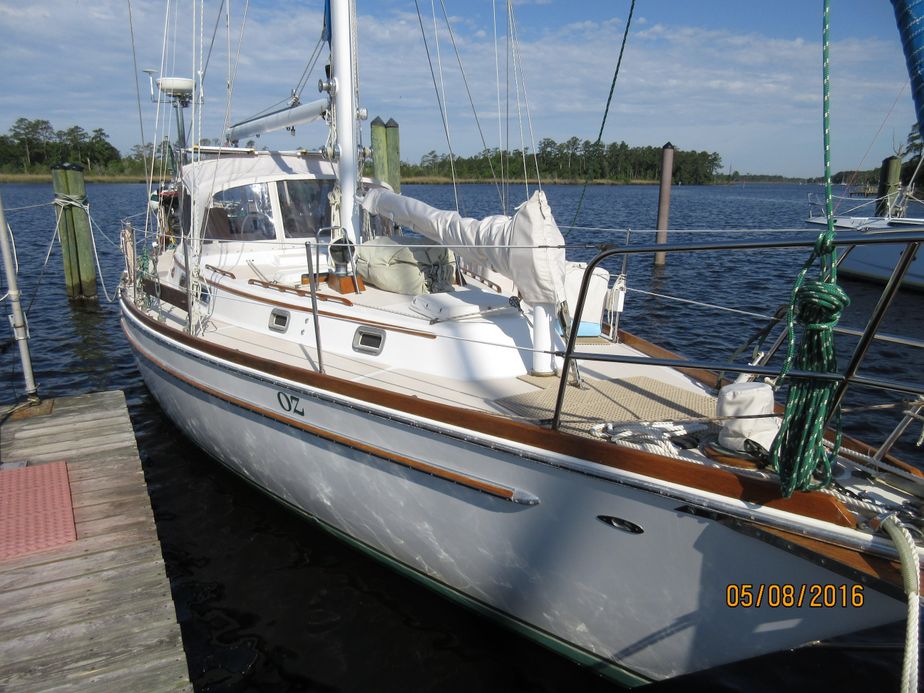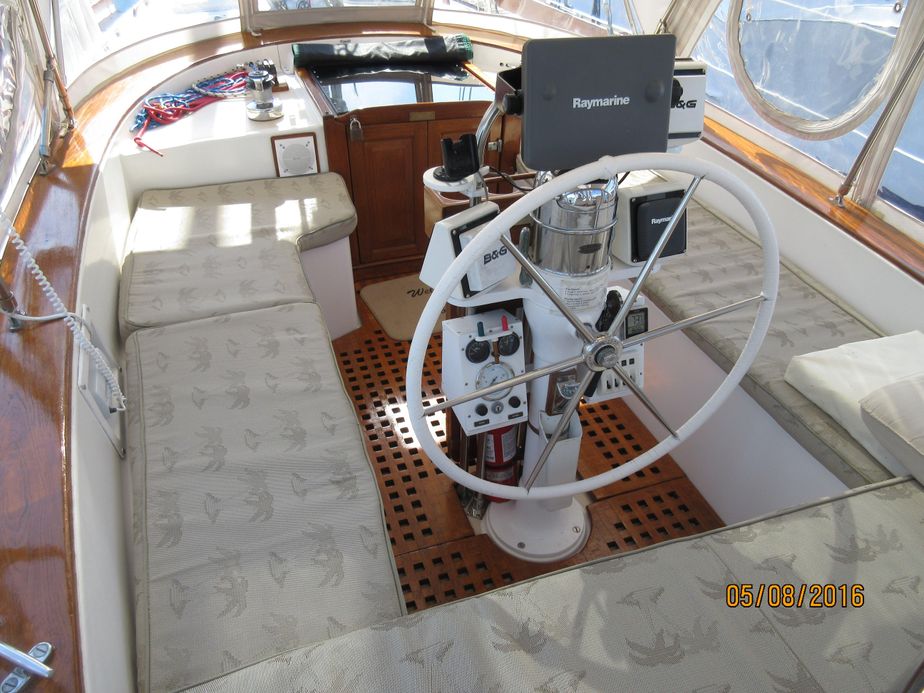I was originally planning to post about the individual boats we're interested in before our east coast road trip over Memorial Day weekend, but house sale & moving stuff got in the way and then it was a very busy trip (11 yachts, 6 days, 3 states, 3 flights, 1365 driving miles!). Instead I'm going to write individual posts about each boat that we saw. Dawn may also edit a few of these posts to add her thoughts.
We flew into Raleigh-Durham late Friday night, rented a car, and drive a half-hour southeast to Clayton for the night. We were up early the next morning to drive to New Bern, where we had an appointment to look at two different Gulfstar 44s, both listed with the same broker within a few days of each other. They had both been on the market for less than a month. Oz was the slightly older (1981) and lower priced of the two at $124,900, and also seemed to be less well-equipped for cruising as she lacked a diesel generator, wind generator, watermaker, and single sideband (SSB) high-frequency radio. On her Yachtworld listing, Oz looked cosmetically about the same as the other Gulfstar ("Radiance"). This turned out to not be the case at all.
Walking up to Oz, she made a really nice first impression. The topsides and deck paint was fresh, the teak rubrail, toerail, and cockpit combings were well varnished, there was a nice radar arch with dinghy davits and a solar panel (with two more on the bimini), there was a beautifully done full cockpit enclosure with roll-up issenglass curtains, and the running rigging for the cutter sailplan was nicely laid out. Below, the impression of care and taste continued. A lot of this was cosmetic, but looking under the floorboards and in the engine room it was clear that the standard of care included mechanical systems as well. The broker had also done a nice job of staging the vessel, and it ended up being one of Dawn's favorites of the trip. She liked the room and stowage in the aft stateroom and the way that the galley extended a little ways aft of the companionway to provide extra counter space while still being narrow enough to be secure in a seaway. Before the trip, Dawn indicated a strong preference for a walkaround queen berth in the aft cabin, but ended up liking Oz's "romper room style" king with insert. The overall layout of the Gulfstar 44s is really livable and this one in particular was very homey.
The downside was that Oz had her original Perkins engine as well as her original standing rigging and chainplates. Mind you, marine diesels are tough engines that will run a long time with the proper care, but there's no denying that an engine with thirty-year old gaskets and seals is going to have to be overhauled at some point, if not replaced outright. Meanwhile the standing rigging looked fairly decent, which is attributable to the fact that the boat spend the first 20 years of its life in freshwater, but it had now been in saltwater long enough that prudence dictated replacing the standing rigging and chainplates before starting a long cruise. This plus the need for upgraded electrical system components and cruising equipment would make for a very expensive refit; even with a good discount off asking price, Oz would be toward the top of our budget. Still, she made a strong enough impression to make the "Top 5" list, while her theoretically better-equipped sister ship for sale just down the dock did not.
Next up...Radiance, a 1984 Gulfstar 44 Sloop.
We flew into Raleigh-Durham late Friday night, rented a car, and drive a half-hour southeast to Clayton for the night. We were up early the next morning to drive to New Bern, where we had an appointment to look at two different Gulfstar 44s, both listed with the same broker within a few days of each other. They had both been on the market for less than a month. Oz was the slightly older (1981) and lower priced of the two at $124,900, and also seemed to be less well-equipped for cruising as she lacked a diesel generator, wind generator, watermaker, and single sideband (SSB) high-frequency radio. On her Yachtworld listing, Oz looked cosmetically about the same as the other Gulfstar ("Radiance"). This turned out to not be the case at all.
S/V Oz
1981 Gulfstar 44 Cutter
Walking up to Oz, she made a really nice first impression. The topsides and deck paint was fresh, the teak rubrail, toerail, and cockpit combings were well varnished, there was a nice radar arch with dinghy davits and a solar panel (with two more on the bimini), there was a beautifully done full cockpit enclosure with roll-up issenglass curtains, and the running rigging for the cutter sailplan was nicely laid out. Below, the impression of care and taste continued. A lot of this was cosmetic, but looking under the floorboards and in the engine room it was clear that the standard of care included mechanical systems as well. The broker had also done a nice job of staging the vessel, and it ended up being one of Dawn's favorites of the trip. She liked the room and stowage in the aft stateroom and the way that the galley extended a little ways aft of the companionway to provide extra counter space while still being narrow enough to be secure in a seaway. Before the trip, Dawn indicated a strong preference for a walkaround queen berth in the aft cabin, but ended up liking Oz's "romper room style" king with insert. The overall layout of the Gulfstar 44s is really livable and this one in particular was very homey.
The downside was that Oz had her original Perkins engine as well as her original standing rigging and chainplates. Mind you, marine diesels are tough engines that will run a long time with the proper care, but there's no denying that an engine with thirty-year old gaskets and seals is going to have to be overhauled at some point, if not replaced outright. Meanwhile the standing rigging looked fairly decent, which is attributable to the fact that the boat spend the first 20 years of its life in freshwater, but it had now been in saltwater long enough that prudence dictated replacing the standing rigging and chainplates before starting a long cruise. This plus the need for upgraded electrical system components and cruising equipment would make for a very expensive refit; even with a good discount off asking price, Oz would be toward the top of our budget. Still, she made a strong enough impression to make the "Top 5" list, while her theoretically better-equipped sister ship for sale just down the dock did not.
Next up...Radiance, a 1984 Gulfstar 44 Sloop.






I had a similar vintage Gulfstar 39 with similar vintage Perkins 4-108 that was trouble free and have many friends who had no issues with these engines. Don't expect aircraft style maintenance records but most of these engines will be fine if they have clean fuel. Do consider cleaning out the fuel tank, my boat even came with a 6" inspection port installed which made the process fairly easy.
ReplyDeleteYeah, this one was a 4-154, they're also known as pretty good engines but a bit harder to find parts for than the 4-108. If the boat we buy has a reliable original engine and it's running well I'm not going to mess with it - just keep maintaining it regularly and hope the reliability continues over 3 seasons of heavy usage. The problem is that when buying, it's pretty hard to know what kind of life the engine has had until now. The condition & layout of the engine room & presence of aftermarket components is a good clue, if they kept records that's a good one too, but neither is foolproof. And any 30-35 year old engine with 4000 hours is going to be 33-38 years old with 6000 hours at the end of our cruise when we're looking to sell the boat. So even if I'm hoping to get away without a repower, I think I need to budget for it when looking at any boat with its original engine.
ReplyDelete